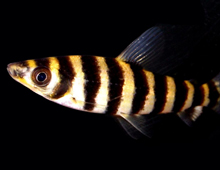Description: The Black-banded leporinus is so named because fasciatus means banded and Leporinus means snout like a rabbit. Their two front teeth are also rabbit-like. It is an eye-catching relative of tetras and piranhas. The bold, bands of yellow and black alternates, with a total of 9 or 10 black bands at maturity. Younger fish have fewer black bands, which split as the fish matures. The nose has a dark spot and the first black bar runs over the eyes.
Size: In their native habitat, they reach about 12 inches (30 cm) in length. Females are slightly larger than males.
Behavior: Black-banded leoporinus are quite active and can swim fast. Like most Acnostomids, they are gregarious in the wild. Due to often positioning themselves with the head down in crevices, they are also known referred to as Banded headstanders.
Diet: They are omnivorous, eating vegetative matter, worms, insects, crustaceans and other fish.
Reproduction: Black-banded leporinus are oviparous. It is believed that a nest is prepared, fertilization is external and eggs are tended to by the male.
Habitat/range: This freshwater species is native to flooded forests and sandy and rocky river beds in South America. Their range is throughout much of the Orinoco and Amazon systems and their major
tributaries in Bolivia, Brazil, Peru, Venezuela and possibly French Guiana, Guyana and Suriname.
Status: Leporinus fasciatus are not evaluated by IUCN.



